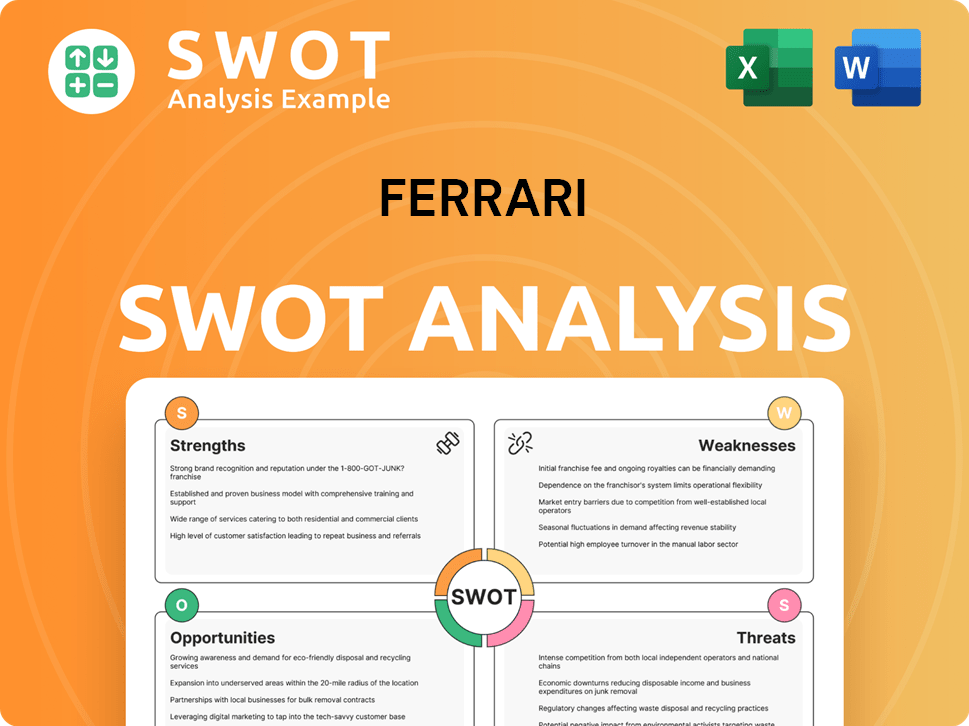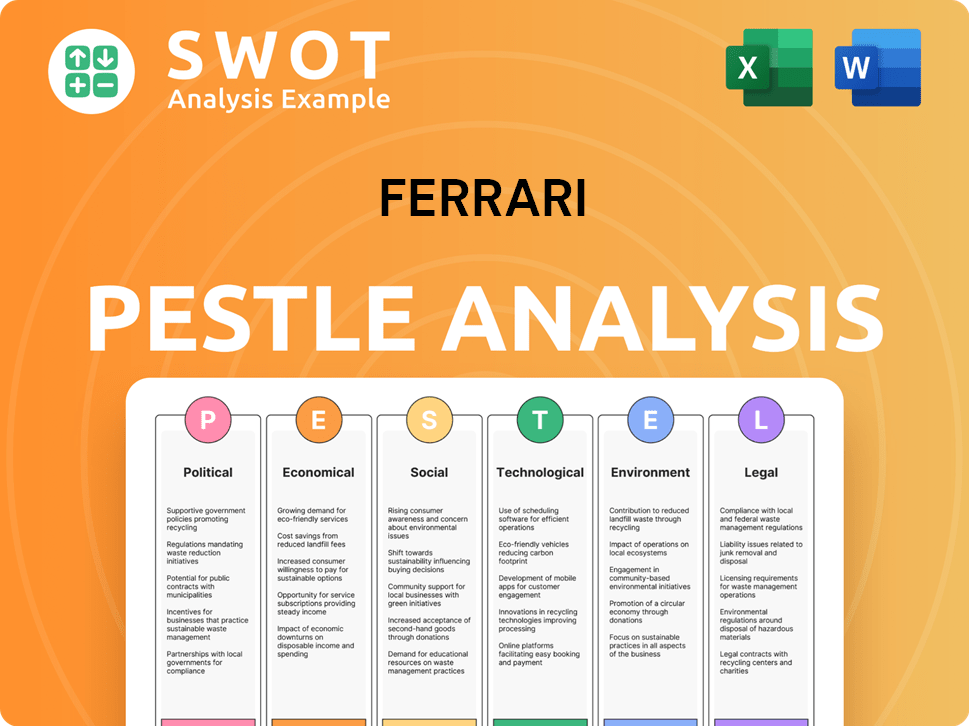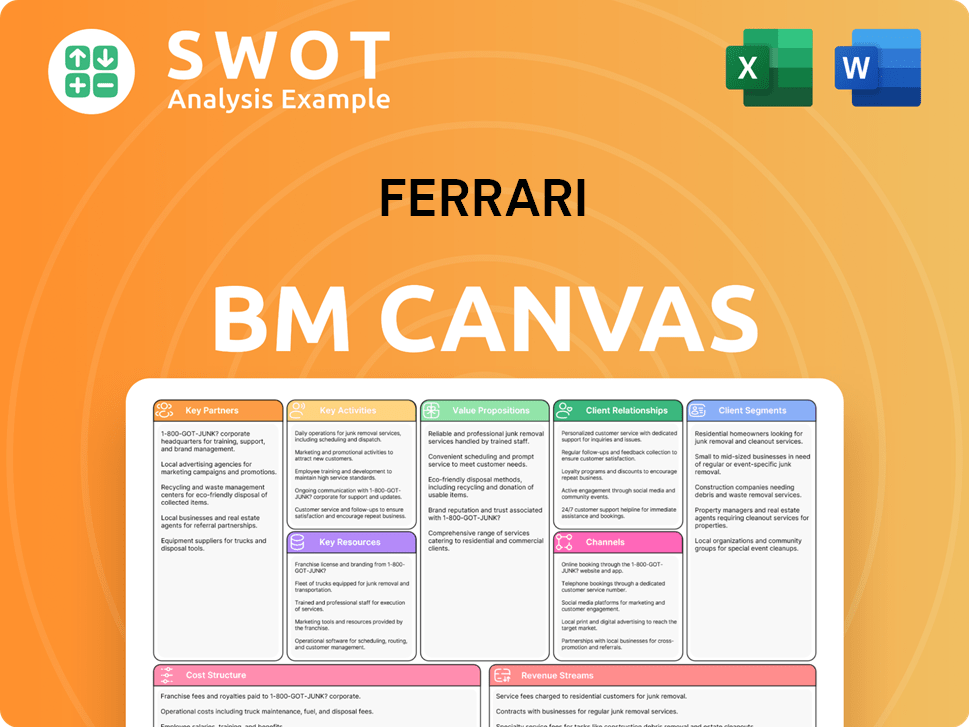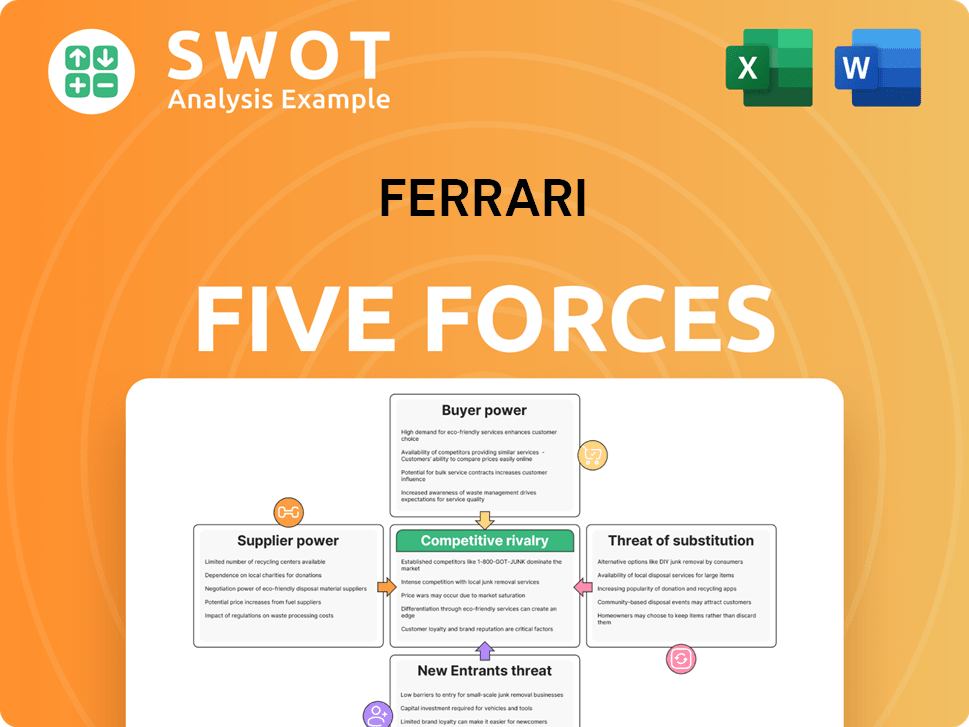Ferrari Bundle
How Does Ferrari Thrive in the Luxury Automotive World?
Ferrari, the legendary Italian marque, isn't just about fast cars; it's a financial powerhouse. In 2023, the company showcased its financial strength with record revenues, demonstrating its enduring appeal and global expansion. This article dives deep into the inner workings of Ferrari, exploring its unique approach to the automotive industry.

Beyond the roar of the engine and the allure of the Ferrari SWOT Analysis, understanding Ferrari's operations is crucial. We'll explore the Ferrari business model, from the Ferrari manufacturing process to its strategic maneuvers, revealing how it maintains its competitive edge. This analysis will also examine Ferrari's engineering innovations and its relationship with Formula 1, offering a comprehensive look at a true automotive icon.
What Are the Key Operations Driving Ferrari’s Success?
Ferrari's core operations are centered around the design, engineering, and production of high-performance luxury sports cars. This process caters to an exclusive clientele that values exceptional performance, sophisticated design, and the brand's rich heritage. The company's product range includes V8 and V12 models, special series, and Icona models, all crafted to deliver a unique driving experience. Ferrari's operational approach blends traditional craftsmanship with cutting-edge technology to ensure exclusivity and superior quality.
The Ferrari operations are characterized by in-house engine development, advanced aerodynamic testing, and personalized customization options for its discerning customers. This approach helps to maintain its brand's exclusivity and value. The company's supply chain is highly specialized, relying on a network of high-quality suppliers for components and materials that meet Ferrari's stringent standards. Distribution is managed through a global network of authorized dealerships, ensuring a consistent brand experience across different regions.
What makes Ferrari's operations unique is its controlled production volume, which intentionally creates scarcity and maintains high demand. For example, in 2023, Ferrari shipped 13,663 units, an increase of 3.3% compared to the previous year. This controlled growth strategy, combined with its direct involvement in Formula 1 racing, allows Ferrari to showcase its technological capabilities. This integration of racing and road car development is a core capability that differentiates Ferrari and translates directly into customer benefits such as superior performance, advanced technology, and an unparalleled brand experience.
The Ferrari manufacturing process combines artisanal craftsmanship with advanced technology. This includes in-house engine development and rigorous aerodynamic testing. Each car is built with meticulous attention to detail, ensuring high quality and performance.
Ferrari's supply chain is highly specialized, relying on a network of premium suppliers. This ensures that all components meet the company's stringent standards. The focus is on quality and reliability to maintain the brand's reputation.
Ferrari's unique approach includes controlled production volumes and direct involvement in Formula 1. This strategy maintains exclusivity and allows for technological advancements. The company's integration of racing and road car development is a key differentiator.
- Controlled production to maintain exclusivity.
- Direct link between Formula 1 and road car technology.
- Focus on personalized customer experiences.
- Commitment to superior performance and design.
Ferrari SWOT Analysis
- Complete SWOT Breakdown
- Fully Customizable
- Editable in Excel & Word
- Professional Formatting
- Investor-Ready Format

How Does Ferrari Make Money?
The monetization strategy of Ferrari is multifaceted, extending far beyond the sale of its luxury vehicles. Ferrari's business model is designed to capitalize on its brand's strength and customer loyalty, ensuring diverse revenue streams. This approach allows Ferrari to maintain its financial health while upholding its image of exclusivity and high performance.
Ferrari's revenue streams are diverse, with car sales being the primary driver. Other significant contributors include engines and components, sponsorships, brand licensing, and financial services. This diversification helps insulate Ferrari from market fluctuations and reinforces its financial stability, supporting its ongoing investments in research and development and Ferrari operations.
Understanding how Ferrari generates revenue is key to appreciating its success. The company’s ability to maintain its exclusivity and command premium prices is central to its financial strategy. Furthermore, Ferrari’s approach to customer service experience and its global market presence are crucial in sustaining its brand value and revenue growth.
The core of Ferrari's revenue comes from selling cars and spare parts. In 2023, this segment generated a substantial €5,109 million. This includes sales of V8 and V12 models, special series, and limited-edition Icona cars.
Revenue from engines and other components reached €159 million in 2023. This primarily involved supplying engines to Maserati, though this agreement ended in late 2023, which will affect future revenue.
This segment significantly contributes to Ferrari's revenue, accounting for €572 million in 2023. It includes income from the Scuderia Ferrari Formula 1 team, sponsorships, and licensing of the Ferrari brand.
Other revenue sources, including financial services and ancillary services, contributed €130 million in 2023. These additional streams enhance Ferrari's overall financial performance.
Ferrari's exclusive limited-edition models are often pre-sold to loyal customers. This strategy boosts their value and collectibility, enhancing revenue.
Ferrari uses a tiered pricing strategy, with higher prices for exclusive vehicles. Customization programs, genuine accessories, and after-sales services boost revenue and customer satisfaction.
Ferrari's financial success stems from a combination of strategies that leverage its brand and product offerings. These strategies include:
- Exclusivity and Limited Production: Ferrari maintains high prices by limiting production, enhancing the desirability of its cars.
- Brand Licensing and Merchandise: The company licenses its brand for various products, generating revenue from merchandise and experiences.
- Formula 1 Participation: Ferrari's involvement in Formula 1 provides significant revenue through sponsorships and brand visibility. Its relationship with Formula 1 is crucial.
- Customization and After-Sales Services: Ferrari offers extensive customization options and after-sales services, increasing revenue per vehicle. Ferrari's car customization options are a key element.
- Global Market Presence: Expanding its presence in key markets worldwide supports sales growth. For more details, check out the Target Market of Ferrari article.
Ferrari PESTLE Analysis
- Covers All 6 PESTLE Categories
- No Research Needed – Save Hours of Work
- Built by Experts, Trusted by Consultants
- Instant Download, Ready to Use
- 100% Editable, Fully Customizable

Which Strategic Decisions Have Shaped Ferrari’s Business Model?
The evolution of Ferrari has been marked by significant milestones and strategic shifts, solidifying its status as a global luxury icon. A crucial moment was the company's IPO in 2015, which provided capital for expansion and established its financial independence. Recent strategic moves include the introduction of new models that diversify its portfolio, such as the Purosangue, Ferrari's inaugural four-door, four-seater vehicle.
This expansion into new segments demonstrates Ferrari's adaptability while maintaining its core identity. The company continues to invest heavily in research and development, particularly in electrification, with its first fully electric vehicle scheduled for late 2025. This addresses industry trends and regulatory pressures while aiming to maintain Ferrari's performance leadership. The Brief History of Ferrari details the journey of this iconic brand.
Ferrari has navigated operational challenges, including global supply chain disruptions that affected the automotive industry. However, its strong brand and controlled production allowed it to overcome these challenges effectively, as evidenced by its record financial results in 2023.
The 2015 IPO was a pivotal moment, providing capital for expansion. The introduction of the Purosangue marked a strategic diversification into new vehicle segments. Investment in electrification, with the first EV planned for 2025, showcases adaptation to industry trends.
Diversification into new vehicle segments, such as the Purosangue. Significant investment in research and development, particularly in electric vehicles. Focus on maintaining brand exclusivity and customer loyalty through tailored experiences.
Unparalleled brand strength built on racing success and automotive excellence. Technological leadership, especially in engine design and performance. Economies of scale within its niche, enabling efficient production of specialized components.
In 2023, Ferrari achieved record financial results, demonstrating resilience. The company's ability to navigate supply chain disruptions highlights its operational strength. Strong customer demand and pricing power contribute to robust financial performance.
Ferrari's competitive advantages are multifaceted, rooted in its brand strength, technological leadership, and operational efficiency. The company benefits from a loyal customer base and a strong global market presence. Ferrari's focus on innovation and its ability to adapt to market trends ensure its long-term success.
- Brand Strength: Decades of racing success and automotive excellence foster immense customer loyalty.
- Technological Leadership: Particularly in engine design and performance, providing a distinct edge.
- Ferrari Ecosystem: Encompassing its racing team, exclusive events, and passionate community, reinforcing its competitive moat.
- Adaptation: Continuous investment in sustainable technologies and digitalization ensures enduring relevance.
Ferrari Business Model Canvas
- Complete 9-Block Business Model Canvas
- Effortlessly Communicate Your Business Strategy
- Investor-Ready BMC Format
- 100% Editable and Customizable
- Clear and Structured Layout

How Is Ferrari Positioning Itself for Continued Success?
Ferrari holds a unique position in the ultra-luxury sports car market, distinguished by strong brand loyalty, limited production, and a global presence. The company's profitability and brand value are consistently high within its niche, with a customer base known for repeat purchases and collecting its cars. Its operations span across key regions including EMEA, the Americas, and China & ROW, making it a globally recognized brand.
Despite its strong market position, Ferrari faces risks such as regulatory changes related to emissions, requiring investment in electrification. The competitive landscape includes rivals like Lamborghini and McLaren. Technological advancements, particularly in battery technology and autonomous driving, necessitate continuous innovation. Furthermore, changing consumer preferences, though less volatile in the ultra-luxury segment, could influence future product development. Understanding the Ferrari business model is crucial for appreciating its market dynamics.
Ferrari dominates the ultra-luxury sports car market with exceptional brand value and customer loyalty. Its exclusivity and limited production enhance its appeal. The company's global reach ensures a broad customer base across key regions.
Regulatory changes, especially regarding emissions and internal combustion engines, pose a challenge. Competition from rivals like Lamborghini and McLaren is intense. Technological disruptions in areas like battery technology require continuous adaptation. Consumer preference shifts could also impact future product development.
Ferrari is focused on electrification, brand expansion, and maintaining exclusivity. The launch of its first fully electric vehicle in late 2025 is a key milestone. The company plans to expand into luxury lifestyle products. Innovation and preserving core values are key to its strategy.
Ferrari aims to strategically manage its product portfolio and embrace new technologies. It plans to enhance the allure of its brand to ensure continued profitability. The company's commitment to innovation and exclusivity will drive its future success.
Ferrari's strategic initiatives focus on electrification and brand expansion. The Ferrari manufacturing process is designed to maintain exclusivity and high standards. The company's strong financial performance is supported by its ability to generate revenue through strategic product management and brand enhancement. The company's commitment to innovation and exclusivity will drive its future success.
- Ferrari plans to launch its first fully electric vehicle in late 2025.
- The company is expanding its presence in luxury lifestyle products.
- Ferrari aims to sustain revenue generation through strategic product management.
- The company is focused on innovation while preserving core values.
Ferrari Porter's Five Forces Analysis
- Covers All 5 Competitive Forces in Detail
- Structured for Consultants, Students, and Founders
- 100% Editable in Microsoft Word & Excel
- Instant Digital Download – Use Immediately
- Compatible with Mac & PC – Fully Unlocked

Related Blogs
- What are Mission Vision & Core Values of Ferrari Company?
- What is Competitive Landscape of Ferrari Company?
- What is Growth Strategy and Future Prospects of Ferrari Company?
- What is Sales and Marketing Strategy of Ferrari Company?
- What is Brief History of Ferrari Company?
- Who Owns Ferrari Company?
- What is Customer Demographics and Target Market of Ferrari Company?
Disclaimer
All information, articles, and product details provided on this website are for general informational and educational purposes only. We do not claim any ownership over, nor do we intend to infringe upon, any trademarks, copyrights, logos, brand names, or other intellectual property mentioned or depicted on this site. Such intellectual property remains the property of its respective owners, and any references here are made solely for identification or informational purposes, without implying any affiliation, endorsement, or partnership.
We make no representations or warranties, express or implied, regarding the accuracy, completeness, or suitability of any content or products presented. Nothing on this website should be construed as legal, tax, investment, financial, medical, or other professional advice. In addition, no part of this site—including articles or product references—constitutes a solicitation, recommendation, endorsement, advertisement, or offer to buy or sell any securities, franchises, or other financial instruments, particularly in jurisdictions where such activity would be unlawful.
All content is of a general nature and may not address the specific circumstances of any individual or entity. It is not a substitute for professional advice or services. Any actions you take based on the information provided here are strictly at your own risk. You accept full responsibility for any decisions or outcomes arising from your use of this website and agree to release us from any liability in connection with your use of, or reliance upon, the content or products found herein.